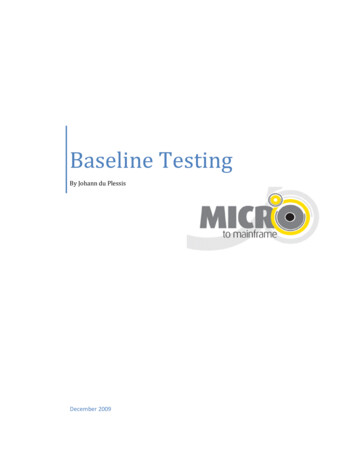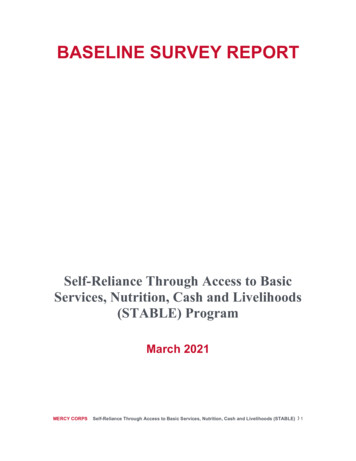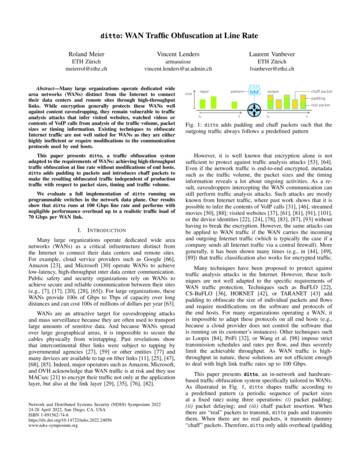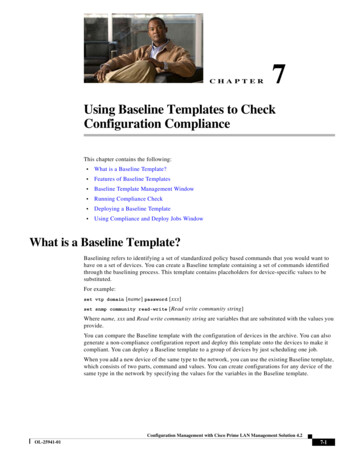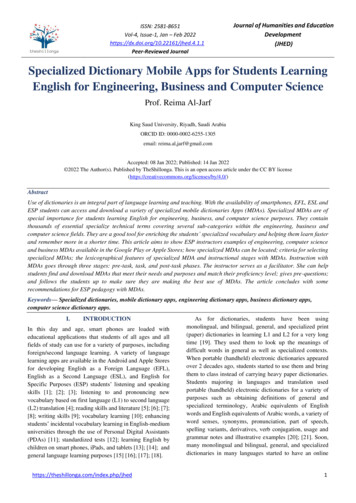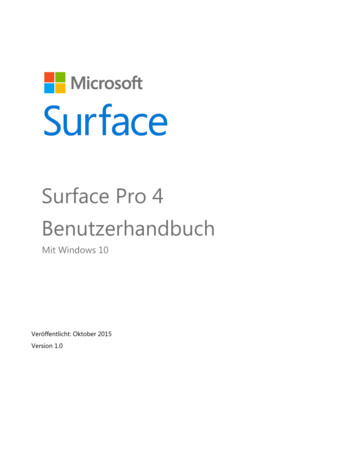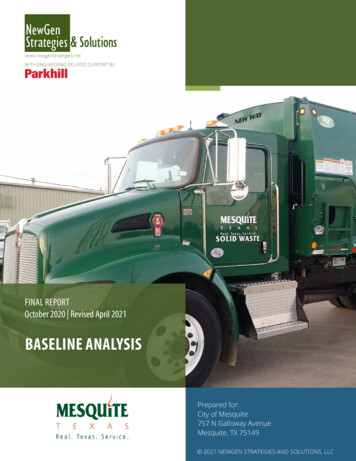
Transcription
www.newgenstrategies.netWITH ENGINEERING RELATED SUPPORT BY:FINAL REPORTOctober 2020 Revised April 2021BASELINE ANALYSISPrepared for:City of Mesquite757 N Galloway AvenueMesquite, TX 75149 2021 NEWGEN STRATEGIES AND SOLUTIONS, LLC
This page left intentionally blank to facilitate double-sided printing.
Table of ContentsSection 1 Introduction . 1-11.1 Location & Government . 1-11.2 Population . 1-41.3 Waste Generation Sectors . 1-5Section 2 Solid Waste System Overview . 2-12.1 Generation . 2-1Tonnage Projection . 2-1Composition of Waste . 2-3Composition of Recyclables. 2-42.2 Education and Outreach Efforts . 2-52.3 Collection . 2-6Residential Garbage . 2-6Residential Recycling . 2-6Residential Yard Waste. 2-7Residential Large Brush and Bulky . 2-8Residential Appliances. 2-9Citizens Convenience and Recycling Center and Compost Facility . 2-9Commercial Collection . 2-9Other Collection Services . 2-92.4 Transfer. 2-92.5 Processing . 2-11Recyclables . 2-11Organics (Yard Waste) . 2-11Appliances . 2-12Electronics . 2-122.6 Disposal. 2-132.7 End Markets. 2-132.8 Other Facilities/Infrastructure . 2-132.9 Other Services. 2-14Section 3 Preliminary Financial Assessment . 3-1Section 4 Preliminary Needs, Gaps, and Opportunities Assessment . 4-1List of AppendicesABPopulation ProjectionsTonnage ProjectionsEconomics Strategy Stakeholders SustainabilityBaseline Analysis
Table of ContentsList of TablesTable 2-1 Transfer Station Weight Comparison 2019 versus 2020 . 2-10List of FiguresFigure 1-1 Map of Mesquite City Boundary . 1-1Figure 1-2 City of Mesquite Solid Waste Division Organizational Chart . 1-3Figure 1-3 Population Projections . 1-4Figure 1-4 Waste Generation Sectors . 1-5Figure 2-1 City-Managed Tonnage Breakdown . 2-2Figure 2-2 Commercial Tonnage Breakdown . 2-2Figure 2-3 Tonnage Projections – Managed by the City . 2-2Figure 2-4 Tonnage Projections – Total Generated in the City . 2-3Figure 2-5 Composition of Residential Waste . 2-4Figure 2-6 Composition of Residential Recycling . 2-5Figure 2-7 City Website Recycling Instructions . 2-7Figure 2-8 Large Brush and Bulky Collection Designated Areas . 2-8iiBaseline Analysis
Section 1INTRODUCTIONThe City of Mesquite (City) retained NewGen Strategies and Solutions, LLC with subconsultant Parkhill forengineering related support (collectively referred to as the “project team”), to develop the City’s Solid WasteMaster Plan. The first step to developing an effective solid waste master plan is to fully understand the currentsolid waste system. The purpose of this report is to describe the current solid waste system and to develop abaseline understanding of the current system’s challenges and opportunities.1.1 Location & GovernmentThe City is located on the east side of the Dallas/Fort Worth Metroplex. It is served by five highways: I-20, I-30,I-635, S.H. 352, and U.S. Highway 80. According to the U.S. Census Bureau, the City has a total area ofapproximately 46.02 square miles (2010), with an estimated population in 2019 of 145,030. The majority of thecity is located in Dallas County, with a small portion located in Kaufman County.Figure 1-1 Map of Mesquite City BoundaryEconomics Strategy Stakeholders SustainabilityBaseline Analysis
Section 1The City is governed by a City Council made up of the mayor, and 6 City Council members. The City Council meetstwice per month. The 2019-2020 Strategic Goals and Objectives for the City include: Safe Community Attractive Neighborhoods Improved Transportation and Mobility Vibrant Economy High Performing/ Transparent Government Quality Recreation and CultureThe City has “a new community vision of setting standards of excellence in areas of services, programs and overallquality of life. Mesquite's innovative programs have led to state, national and international recognition.”1 TheCity’s Mayor, Bruce Archer, expressed a commitment to become the “Safest, Cleanest, Most Employed and theKindest City in America” on his Facebook page in August 2020. Referred to as the “Cleanest City in AmericaInitiative”, Mayor Archer has assembled a task force of community leaders to make recommendations to the CityCouncil for how to accomplish this important goal.The City is a member of the North Central Texas Council of Governments (NCTCOG). The NCTCOG was created in1966 and currently includes the local governments of sixteen counties in north central Texas, with representationfrom 235 political jurisdictions. As noted in the North Central Texas Regional Solid Waste Management Plan,dated October 2015, the NCTCOG’s “primary purposes are to perform long-range, comprehensive plans formatters that transcend jurisdictional boundaries, promote the sound development of the 16-county region, andfacilitate cooperation and coordination among its member governments”.At the federal level, the Resource Conservation and Recovery Act (RCRA), enacted in 1976, is the federal publiclaw that provides the framework for the proper management of hazardous and nonhazardous solid waste. InTexas, the Texas Solid Waste Disposal Act, Texas Health and Safety Code Chapter 361, outlines the state’s policiesregarding the management of solid waste, including hazardous waste. The Texas Commission on EnvironmentalQuality (TCEQ) oversees the management of solid waste in Texas.Ultimately, the City has the responsibility to ensure the management of municipal solid waste is conducted in asafe manner to protect human health and the environment, in compliance with federal and state law. The City’sPublic Works Department has a Solid Waste Division to manage solid waste in the City. Figure 1-2 shows the SolidWaste Division organization 2Baseline Analysis
IntroductionFigure 1-2 City of Mesquite Solid Waste Division Organizational ChartBaseline Analysis1-3
Section 11.2 PopulationFigure 1-3 presents historical and projected population growth patterns for the City, using three scenarios: low,medium, and high growth estimates. Low growth: In this scenario, population is projected based on the compound annual growth rate (CAGR)of the City’s actual population from 2010 to 2020. The CAGR for this period was 0.39%. Medium growth: In this scenario, population is projected based on the CAGR of the combined actualpopulation of Dallas County and Kaufman County from 2010 to 2020 as reported by the NCTCOG 2020Population Estimates. The CAGR for this period was 0.96%. High growth: In this scenario, population is projected based on the CAGR of the combined 2040 projectedpopulation made by the NCTCOG. The CAGR for this period is 1.36%.The City also provided projected development of new homes that will be built over a 10-year period, which wasevaluated as part of the population projections exercise. The household projection approach tied closely to thehigh growth scenario described above with an estimate of 45,183 homes by 2029; with a CAGR of 1.26%, the Citywould have an estimated 51,884 homes by 2040.As shown in Figure 1-3, the City’s population in 2020 is 145,410. Over the twenty-year planning period (through2040), population in the City is estimated to reach 157,260 in the low growth scenario, 176,166 in the mediumgrowth scenario, and 190,697 in the high growth scenario, by 2040. The detailed population projections areprovided in Appendix A.Population 824142,230145,410FY 2010FY 2015FY 2020157,260100,00050,000Low Growth 0.39%FY 2025FY 2030Medium Growth 0.96%FY 2035FY 2040High Growth 1.36%Figure 1-3 Population Projections1-4Baseline Analysis
Introduction1.3 Waste Generation SectorsFor the purpose of this study, waste generation sectors are primarily segregated into two categories:(1) City-managed waste generated by single family residential and small commercial generators (collectivelyreferred to as “residential”) as well as material dropped off at the Citizens Convenience and Recycling Center andCompost Facility; and (2) multifamily, commercial and industrial generators (collectively referred to as“commercial”), who receive collection services through a City agreement with Republic Services.As indicated in Figure 1-4, according to utility billing data in Fiscal Year (FY) 2019 there were 37,360 single familyunits and 98 small commercial units. According to customer counts provided by Republic Services, there were1,560 commercial units Citywide in 0005,000-1,5601,560FY 201737,45837,3671,560FY 2018Single Family and Small CommercialFY 2019CommercialFigure 1-4 Waste Generation SectorsBaseline Analysis1-5
This page left intentionally blank to facilitate double-sided printing.
Section 2SOLID WASTE SYSTEM OVERVIEW2.1 GenerationTonnage ProjectionThe tonnage generation projections are based on an analysis of historical generation per capita over the last 3years, and population projections described in Section 1.2. Three different approaches were considered for thewaste projections: Scenario 1: Low growth Scenario 2: Medium growth Scenario 3: High growthThese projections assume no material changes in the City’s policies, programs, participating entities, or facilitiesover the planning period, and account only for tonnage increases resulting from projected population growthwithin the City. As the planning process continues, the baseline generation projections may be adjusted as neededto reflect the anticipated impacts of proposed changes being considered for implementation in the solid wastemaster plan.It is important to note that through discussions between the City and the project team, it was decided to usedifferent growth rates for commercial and industrial Municipal Solid Waste (MSW) in each of the three scenariosdue to the rapid increase in commercial businesses in the area. Scenario 1: Low Growth, was estimated at a 1.00%growth rate; Scenario 2: Medium Growth, was estimated at a 1.50% growth rate; and Scenario 3: High Growth,was estimated at a 2.00% growth rate.Figure 2-1 shows the breakdown by material type managed by the City through residential and small commercialcollection and drop off at the Citizens Convenience and Recycling Center and Compost Facility in FY 2020. Figure2-2 shows the general breakdown by material type collected from the commercial/industrial sector by the privatesector in FY 2020.Figure 2-3 shows the three growth scenario projections of total tons managed by the City, which includes tons ofgarbage, bulky items, recyclables, yard waste, and appliances collected alley or curbside as well as materialsbrought to the Citizens Convenience and Recycling Center by residents, and yard waste deposited at the CompostFacility. Figure 2-4 shows projections of total tons generated in the City, including materials managed by the Cityand the commercial sector garbage and recyclables collected by Republic Services (with whom the City contractsfor commercial collection). In FY 2020, the City managed 114,083 tons, and the commercial sector generatedanother estimated 63,132 tons.Over the 20-year planning period (through 2040), tons managed by the City is estimated to reach 113,690 tons inthe low growth scenario, 126,928 tons in the medium growth scenario, and 137,073 tons in the high growthscenario, by 2040. Overall tons projected to be generated (residential plus commercial) in the City is estimatedto reach 193,624 tons in the low growth scenarios, 215,200 tons in the medium growth scenario, and 234,405tons in the high growth scenario, by 2040. The detailed tonnage projections are provided in Appendix B.Economics Strategy Stakeholders SustainabilityBaseline Analysis
Section 2FY 2020FY yclingGarbage and Bulky WasteCommercial MSWIndustrial MSWResidential Yard WasteCommercial Yard WasteCommercial RecyclingIndustrial RecyclingFigure 2-1 City-Managed Tonnage BreakdownFigure 2-2 Commercial Tonnage 95,00090,000FY 2021FY 2025Low (0.39%)FY 2030Medium (0.96%)FY 2035FY 2040High (1.36%)Figure 2-3 Tonnage Projections – Managed by the City2-2Baseline Analysis
Solid Waste System 50,000140,000FY 2021FY 2025Low (0.39%)FY 2030Medium (0.96%)FY 2035FY 2040High (1.36%)Figure 2-4 Tonnage Projections – Total Generated in the CityComposition of WasteA composition study of the City’s waste was completed in 2019, as part of a larger composition study completedfor the NCTCOG planning region, the results of which are shown in Figure 2-5. The City of Mesquite wastecomposition is based on garbage loads from residential routes. The largest constituents are shown to be organics(45.26%), paper (22.38%), and plastic (17.52%).The organics category includes yard waste (0.5%), food waste (38.3%) and other organics (6.4%). The papercategory includes newsprint, recyclable corrugated cardboard, non-recyclable (due to contaminants) corrugatedcardboard, kraft paper/paperboard, high grade office paper, magazines/glossy, polycoated/aseptic containers,mixed (other recyclables), and other (non-recyclable). The plastic category includes PET containers, HDPEcontainers – natural and colored HDPE containers, #3 - #7 containers, and non-recyclable plastics.Based on the 2019 waste composition study results, approximately 30% of materials currently placed in thegarbage could be placed in the recycling bins or bags.Baseline Analysis2-3
Section 2C&D, 0.04%Problem Materials,0.39%Organics, 45.26%Other, 4.46%Paper, 22.38%Glass, 6.42%Metals, 3.53%Plastic, 17.52%Figure 2-5 Composition of Residential WasteComposition of RecyclablesFigure 2-6 shows the composition of the residential recycling material stream, based on City-provided data. Mixedpaper is the largest percentage at 55% of the recycling material stream, followed by contaminants at 24%. Asdescribed in Section 2.4 below, the City and the region are making efforts to reduce contamination in the recyclingmaterial stream through efforts such as the “Know What to Throw” campaign. The volatility of the recyclingmarkets is exacerbated by contamination in the recycling material stream, which is a common problem in mostresidential recycling collection programs. Contamination reduces the efficiency of processing and the quality ofmaterials to be sold.2-4Baseline Analysis
Solid Waste System OverviewFY 2019Recycle Bindings-trash,24%Plastic ( All ), 19%Mixed Paper, 55%Aluminum Cans, 1%Tin/Steel Cans, 2%Figure 2-6 Composition of Residential Recycling2.2 Education and Outreach EffortsThe City is partnering with the NCTCOG to launch the “Know What to Throw”recycling education campaign. The City’s website2 provides a description of thecampaign and provides links to TimeToRecycle.com that encourages everyone torethink waste as a resource. The information available on the site shows residentswhat should be recycled and what is not acceptable. The City’s own residentialrecycling program webpage provides information for how a resident can receivea green bin, and what day to set out recyclables. Multifamily residents wantingto recycle can do so at the Citizens Convenience and Recycling Center. The Cityhosts annual neighborhood meetings in October (associated with National NightOut) that, on occasion, include speakers from the Solid Waste Division to promoteall of its solid waste related programs. Presentations in neighborhoods and athomeowner’s association meetings have also occurred from time to time whenrequested, though not since the COVID-19 pandemic began in March of 2020.Every resident receives a 16-page Guide to Solid Waste & Recycling when theysign up for water service.The recently passed State Senate Bill 649 relating to the promotion of the use ofrecyclable materials as feedstock for processing and manufacturing was filed during the 86th Legislative Sessionand took effect on September 1, 2019. This bills mandates that the Texas Commission on Environmental Quality(TCEQ) research methods to encourage the use of recyclables as inputs for the creation of new products, which ispart of a larger plan to invest in, expand, and promote the state’s recycling economy. Among other things, this l-Recycling-ProgramBaseline Analysis2-5
Section 2requires an education campaign that encourages clean materials in the recycling stream. The State of TexasAlliance for Recycling (STAR) was a driving force behind the legislation.2.3 CollectionThe City provides alley or curbside collection of household garbage, recyclables, yard waste, large brush and bulkyitems, and appliances with municipal crews for roughly 38,000 single family homes. Residents pay for thesecollection services on their monthly utility bill. The FY 2021 rate for these collection services is 22.25, a 1.00increase from the 2020 monthly rate of 21.25. For small commercial customers receiving collection service, theyare charged a monthly fee of 35.00.The City Code of Ordinances Article I, Chapter 14 – Solid Waste provides regulations relating to solid waste in theCity. Per Section 14-13, the “collection of trash, yard waste or solid waste within the City by any person otherthan the City or a company contracting with or permitted by the City for waste collection is prohibited”. Section14-21 states that all collection of solid waste must occur between the hours of 7:00 a.m. and 9:00 p.m. in areas inor within 1,000 feet of a residence. Specific ordinance language related to how and where customers set outmaterials for collection are also included, which allows solid waste supervisors to provide written citations toresidents that do not comply. Currently, supervisors primarily only issue citations for sharps in the garbage, andotherwise focus on educating residents to properly set out materials rather than issuing citations.The following subsections provide a general overview of collection services. A more detailed Operational Reviewof Residential Collection Services will be conducted in a subsequent task.Residential GarbageResidential customers are provided garbage collection service twice per week, either on Monday and Thursday oron Tuesday and Friday, using rear load vehicles. Residential customers are required to provide their own garbagereceptacles. The gross weight of a container with contents should not exceed 50 pounds. The contents of thecontainer are required by ordinance to be securely closed to prevent spillage of contents. Plastic bags may beused in place of metal or plastic containers provided that all such bags are securely tied and of 2 mil thickness toprevent spillage of contents. There is no limit on the number of containers or bags a resident may set out forcollection. Garbage is delivered to the City’s Transfer Station where it is consolidated and then transported toWaste Management of Texas, Inc.’s Skyline Landfill.Houses with paved alleys may place garbage on the property line nearest the alley, outside their fence (ifapplicable), and must not block any portion of the alley. Racks and platforms are permitted for the placement ofcontainers for houses with alleys provided they meet the specifications defined in Chapter 14. For houses withoutpaved alleys, garbage may be placed on the edge of the curb adjacent to the street and must not block any portionof the street or sidewalk.In FY 2020, the City collected nearly 65,000 tons of garbage (including bulky items).Residential RecyclingResidential customers are provided recycling collection service once per week on one of the scheduled garbagecollection days, using rear load vehicles. Green 18-gallon recycling bins are provided by the City to residentialcustomers on request. Residents may also use blue recycling bags which can be purchased from the City. Similarto garbage, houses with paved alleys may place recyclables on the property line nearest the alley, outside theirfence (if applicable), and must not block any portion of the alley. Racks and platforms are permitted for theplacement of containers for houses with alleys provided they meet the specifications defined in Chapter 14. For2-6Baseline Analysis
Solid Waste System Overviewhouses without paved alleys, recyclables may be placed on the edge of the curb adjacent to the street and mustnot block any portion of the street or sidewalk. Recyclables are direct hauled to the City’s contracted recyclablesprocessor, FCC, located in Dallas.Figure 2-7 shows the materials included in the City’s residential recycling program as posted on the City’s website,which include aluminum and steel cans, food and beverage cartons, glass bottles and jars, cereal boxes,newspapers, magazines, mail, flattened cardboard, and plastic bottles and containers. Glass may not be placed ina blue bag, only in a recycling bin. Materials are collected in a single stream, meaning all recyclable materials areplaced in the same bin or bag (except for glass, if a bag is used).It is estimated that approximately one-third of the households participate in the City’s residential recyclingprogram. Note that due to the COVID-19 pandemic, the City temporarily suspended the residential recyclingcollection service in March of 2020. The service began again in October of 2020.In FY 2020, the City collected approximately 1,200 tons of recyclables through alley/curbside collection as well asthe drop off facility located at the Citizens Convenience and Recycling Center.Figure 2-7 City Website Recycling InstructionsResidential Yard WasteResidential customers are provided yard waste collection service once per week, on Wednesday, using rear loadvehicles. Yard waste should be placed in plastic bags or kraft bags designed for the purpose of holding grassclippings and leaves. Branches and tree limbs may be placed in a pile no longer than 6 feet and no higher than4 feet. As yard waste is collected, collection personnel debag at each stop. Yard waste is delivered to the City’sCompost Facility. Approximately 20,407 tons of yard waste was collected from residential customers in FY 2020.Baseline Analysis2-7
Section 2Similar to garbage, houses with paved alleys may place yard waste on the property line nearest the alley, outsidetheir fence (if applicable), and must not block any portion of the alley. For houses without paved alleys, yard wastemay be placed on the edge of the curb adjacent to the street and must not block any portion of the street orsidewalk.Residential Large Brush and BulkyResidential customers are provided large brush and bulky collection service once per week of an unlimited amountof material. Residents do not have to call ahead for service. Collection is provided Monday through Friday, bydesignated area, as shown in Figure 2-8. The large brush and bulky is collected in Roto-boom (“boom”) vehicles.Each boom vehicle operator runs the entire route for brush and creates a list of bulky items to collect when thebrush route is complete. Clean brush loads are delivered to the City’s Compost Facility, and bulky loads aredelivered to the City’s Transfer Station.The City also offers a “cost-plus” program for commercial and rental properties, at a rate of 250 per 30 cubicyards. A representative from the City’s solid waste management team visits the location, issues an estimate, andcollects payment before the material is collected.Large brush and bulky items must be placed at the curb adjacent to the street and should not block any portionof the street or sidewalk. Where the sidewalk is adjacent to the curb, large brush and bulky items must be placedadjacent to the sidewalk on the property owner's side of the sidewalk.Figure 2-8 Large Brush and Bulky Collection Designated Areas2-8Baseline Analysis
Solid Waste System OverviewResidential AppliancesAppliances are collected on Wednesdays by a solid waste supervisor using a pickup truck. Residents can place oldrefrigerators, dishwashers, washers, dryers, water heaters, stoves, lawnmowers, scrap metal, and otherhousehold appliances at the curb for pickup. In order to schedule a pickup, residents must call the City’s SolidWaste Division prior to Wednesday, or schedule collection online.Appliances must be placed at the curb adjacent to the street and should not block any portion of the street orsidewalk. Where the sidewalk is adjacent to the curb, appliances must be placed adjacent to the sidewalk onproperty owner's side of the sidewalk.Appliances are hauled to the Citizens Convenience and Recycling Center and Compost Facility and placed in thescrap metal pile. All scrap is delivered to Lake June Metal and sold at the market rate. The City collectsapproximately 200 tons of scrap metal per year. In FY 2020, the City collected roughly 180 tons of appliances fromresidential customers through the curbside collection as well as Citizens Convenience and Recycling Center dropoff.Citizens Convenience and Recycling Center and Compost FacilityThe Solid Waste Division operates a combined Citizens Convenience and Recycling Center and Compost Facilitythat allows residents to deliver brush and yard waste, recycled material, and electronic waste. Commerciallandscapers can also drop off yard waste at the Compost Facility. The Center provides the City’s residents theability to dispose of junk and other items at no cost. The Center is open Monday through Saturday from 9:00 a.m.to 4:00 p.m. and is closed on Wednesday, Sunday, and holidays. As previously described, the residential recyclingcollection service was temporarily discontinued in March of 2020 due to the COVID-19 pandemic. From March 23through July 25, 2020, 1,132 residents delivered blue bags/green bins recycling to the Citizens Convenience andRecycling Center and Compost Facility.Commercial CollectionCommercial collection of garbage and recyclables is provided via a contract between the City and RepublicServices, Inc. (Republic Services). Businesses contract directly with Republic Services for collection of garbage inthe size dumpster and frequency of service agreed upon between the customer and Republic Services.Commercial customers can also request and receive collection of recyclables from Republic Services. RepublicServices pays the City a monthly flat “Agreement Fee” as well as a street and alley use fee of 10% of gross revenues.Other Collection ServicesThe Solid Waste Division provides additional collection services throughout the City. These addi
The City is a member of the North Central Texas Council of Governments (NCTCOG). The NCTCOG was created in 1966 and currently includes the local governments of sixteen counties in north central Texas, with representation from 235 political jurisdictions. As noted in the North Central Texas Regional Solid Waste Management Plan,

